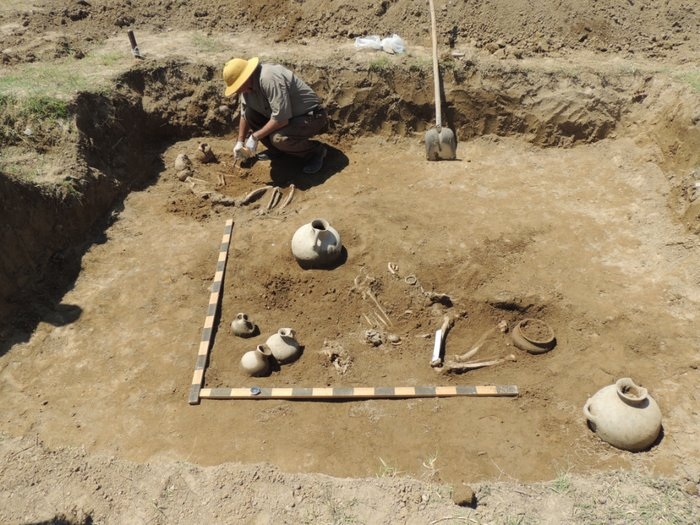Necropolis in Karabakh proves Armenian lies

By Sara Rajabova
Armenian falsifiers have repeatedly claimed that the Nagorno-Karabakh region of Azerbaijan belongs to them, trying to prove their claims with falsification of facts and alleged historical documents.
However, new discoveries in the frontline territories prove the falsehood of the Armenians and confirm that these territories have belonged to the Azerbaijani people from the past.
Thus, new artifacts discovered during archaeological excavations in the "Palidli" necropolis near Mirashelli village, located on the frontline in Azerbaijan's Agdam region, are another proof of that.
The head of the Aghdam expedition of the Institute of Archeology and Ethnography of the Azerbaijan National Academy of Sciences (ANAS), Professor Idayat Jafarov said a burial dating back to the XII-XI centuries BCE was found in Palidli.
There was a teenager's body in the burial. "The deceased is buried in a flexed position, on his right side, with the head facing the west, and feet to the east. Around him were different types of pottery, such as jars with two handles and bowls, decorated with geometric designs of that epoch," Jafarov said.
The scholar also said that the study of the necropolis, in which about twenty burials were revealed, started four years ago. Numerous ceramic items, jewelry (bracelets, rings, earrings, beads made from agate, glass and bronze) were found at the burial. All the skeletons lie on the side in a bent position.
The findings, which refer to people of different social status, are ascribed by archaeologists to the Khojaly-Gadabay culture of the Bronze and early Iron Ages.
"A laboratory analysis of these artifacts once again confirms the groundlessness of the territorial claims of the Armenians: the plains and mountainous territory of Karabakh have been historically inhabited by representatives of one culture, the Turkic culture," Jafarov said.
The excavations in the "Palidli" necropolis continue and archaeologists believe that the confirmation of this hypothesis will be found more than once.
As is known, epigraphy helps scientists to produce convincing, reliable facts of the historical affiliation of the Azerbaijani territories, which Azerbaijan's hostile neighbor claims.
Years of research by ANAS corresponding member Meshadi Nemat have produced valid evidence of this fact. These studies, which concern the occupied territories, are reflected in the collections which include the Arabic, Persian and Turkic inscriptions of Shirvan, Ganja, Agdam, Fizuli, Shusha, Zengilan, Jabrayil, Lachin, Kalbajar and other regions, dating back to the period from XI to the early XX century. These are construction inscriptions, epitaphs, etc.
The titles, epithets of Azerbaijani rulers and other valuable evidence and facts that allow to get answers to the questions raised by historians are indicated in them.
According to the director of the ANAS Archeology and Ethnography Institute Maisa Rahimova, paying close attention to the archaeological research of the contact-line territories started in 2011.
Extensive research has been conducted in Aghdam, Aghjabedi and other areas. Historical, archeological and architectural monuments of Azerbaijan remained in the occupied Karabakh.
"One can only imagine in what condition they are now and how the Armenians treat them. The Armenians rob, destroy and present as their own (these monuments), that is, they are involved in their usual scientific falsification," Rahimova said.
"Material damage caused by vandalism is impossible to determine as all our historical and archaeological monuments are invaluable. This is our history, our life," the scientist said.
After invading Azerbaijan's territories Armenia embarked on a campaign of ruining the cultural and historical monuments of the Azerbaijani people. The Armenians are also appropriating monuments of the ancient Caucasus Albania. A variety of ancient Albanian scripts, wall designs and crosses have been replaced by Armenian attributes. A number of mosques are used as storehouses. Buildings as well as unique exhibits of the museums located in the occupied Azerbaijani lands have been either destroyed or used as a basis for new museums, and the Armenians thus claim they belong to them.
Azerbaijan has repeatedly expressed concern over the issue of the destruction of religious and historical monuments in its occupied territories and is committed to informing the world community of the damage inflicted to its cultural heritage.
The destruction and intentional damage inflicted to the historical and cultural monuments by the Armenian invaders in the occupied territories of Azerbaijan contradict the 1954 Hague convention on preservation of cultural values during armed conflicts, the 1992 European convention on preservation of archeological heritage, and the 1972 UNESCO convention on preservation of world cultural and natural heritage.
For over two decades, Azerbaijan and Armenia have been locked in conflict which emerged over Armenia's territorial claims against its South Caucasus neighbor. Since a war in the early 1990s, Armenian armed forces have occupied 20 percent of Azerbaijan's territory, including Nagorno-Karabakh and seven surrounding regions. A fragile ceasefire has been in place since 1994, but long-standing efforts by US, Russian and French mediators have been largely fruitless so far. Armenia has not yet implemented the U.N. Security Council's four resolutions on its pullout from the neighboring country's territories.
Here we are to serve you with news right now. It does not cost much, but worth your attention.
Choose to support open, independent, quality journalism and subscribe on a monthly basis.
By subscribing to our online newspaper, you can have full digital access to all news, analysis, and much more.
You can also follow AzerNEWS on Twitter @AzerNewsAz or Facebook @AzerNewsNewspaper
Thank you!
